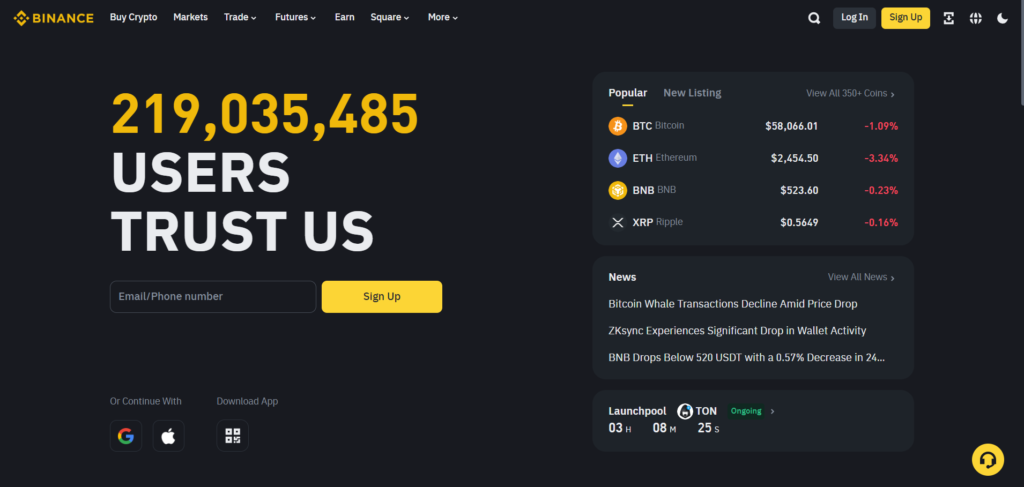Cryptocurrency has revolutionized the financial landscape, offering new avenues for investment and speculation. Among the various instruments available for trading cryptocurrencies, crypto futures have gained significant traction.
But what exactly are crypto futures, and how do they work? This article dives deep into the world of crypto futures, providing a comprehensive guide to understanding these contracts, their workings, and the potential benefits and risks involved.
Understanding Cryptocurrency Futures
What Are Crypto Futures?
Crypto futures are financial contracts between two parties where they agree to buy or sell a particular cryptocurrency at a predetermined price on a future date. Unlike spot trading, where you purchase the actual cryptocurrency, futures allow you to speculate on the price movement of the asset without owning it. This opens up opportunities for both hedging and speculative trading.
How Do Crypto Futures Work?
The mechanics of crypto futures are similar to those of traditional futures contracts. Two investors enter into a contract, agreeing on a price at which the cryptocurrency will be traded in the future. The contract specifies the amount of cryptocurrency involved, the agreed-upon price, and the expiration date.
When the contract expires, the investor who agreed to buy the cryptocurrency will do so at the agreed price, regardless of the market price at that time. Conversely, the seller will deliver the cryptocurrency at the contract price, whether it’s advantageous or not.
Key Features of Crypto Futures
- Leverage: One of the key attractions of futures trading is leverage. Leverage allows traders to control a large position with a relatively small amount of capital, amplifying both potential profits and losses.
- Margin Requirements: To trade futures, traders must maintain a margin account. This account holds a portion of the total trade value, acting as collateral. The margin requirement varies depending on the exchange and the specific cryptocurrency.
- Settlement Methods: Crypto futures can be settled either in cash or by physical delivery. Cash settlement is more common, where the difference between the contract price and the market price at expiration is settled in cash.
The History of Crypto Futures

The Evolution of Crypto Futures Trading
The concept of crypto futures isn’t new; it dates back to 2017 when the Chicago Board Options Exchange (CBOE) and the Chicago Mercantile Exchange (CME) introduced Bitcoin futures. This was a significant milestone, marking the entry of cryptocurrencies into mainstream financial markets.
The Role of CME and CBOE
CME and CBOE played crucial roles in legitimizing crypto futures. While CBOE discontinued its Bitcoin futures in 2019, CME has continued to expand its offerings, including both Bitcoin and Ether futures. These contracts are traded on the Globex electronic trading platform and are settled in cash, based on the CME CF Bitcoin Reference Rate and the CME CF Ether Reference Rate.
Why Trade Crypto Futures?
Benefits of Trading Crypto Futures
Trading crypto futures offers several advantages:
- Hedging Against Price Volatility: Crypto markets are notoriously volatile. Futures allow traders to hedge against adverse price movements, providing a level of protection in uncertain markets.
- Access to High Leverage: As mentioned earlier, leverage allows traders to amplify their exposure to the market, potentially leading to higher profits with a relatively small investment.
- No Need to Own the Cryptocurrency: Since futures are derivative contracts, traders can gain exposure to cryptocurrency price movements without actually owning the underlying asset. This simplifies the trading process, as there’s no need for wallets or custody solutions.
Risks Involved in Crypto Futures Trading
While the potential for profit is high, so is the risk. The leverage that magnifies gains also amplifies losses. Furthermore, the volatile nature of cryptocurrencies can lead to significant price swings, making futures trading a high-risk activity.
Trading on Regulated vs. Unregulated Exchanges
Regulated Exchanges
Regulated exchanges, like CME, offer a more secure environment for trading crypto futures. These platforms are subject to oversight by government agencies, such as the Commodity Futures Trading Commission (CFTC) in the U.S. This regulation provides a layer of protection for traders, ensuring that the exchange operates within legal and ethical guidelines.
Unregulated Exchanges
In contrast, unregulated exchanges often operate with fewer restrictions, allowing for higher leverage and more risk. While this can lead to greater profit potential, it also exposes traders to the possibility of significant losses. For example, Binance, one of the largest cryptocurrency exchanges, initially offered leverage of up to 125x for its futures contracts, though this was later reduced to 20x due to the associated risks.
Popular Crypto Futures Exchanges

Top Platforms for Trading Crypto Futures
Several platforms dominate the crypto futures trading space:
- Binance: Known for its extensive range of trading pairs and high trading volumes, Binance is a go-to platform for many futures traders.
- CME: As a regulated exchange, CME offers Bitcoin and Ether futures, providing a safer trading environment for institutional investors.
- ByBit: While not available to U.S. customers, ByBit is popular internationally, offering competitive leverage and a wide range of futures contracts.
- OKX: With a broad selection of trading pairs, OKX is another leading platform for crypto futures trading.
- Bitget: Initially a derivatives exchange, Bitget now offers a variety of cryptocurrency futures, making it a versatile platform for traders.
Margin Requirements in Crypto Futures Trading
Margin is the minimum amount of funds a trader must deposit to open a futures position. This amount acts as collateral and varies depending on the exchange and the specific cryptocurrency being traded. For example, CME requires a 50% margin for Bitcoin futures and 60% for Ether futures. These requirements are designed to mitigate the risk of trading such volatile assets.
Position Limits in Crypto Futures
How Position Limits Impact Trading
Position limits are the maximum number of contracts a trader can hold on a particular futures product. These limits vary by exchange and are designed to prevent market manipulation. For instance, CME allows a maximum of 4,000 front-month futures contracts for Bitcoin and 8,000 for Ether.
Trading Volume and Market Impact
Trading volume is a crucial factor in the crypto futures market. High trading volumes can lead to greater liquidity, making it easier to enter and exit positions. However, during periods of extreme volatility, trading volumes can fluctuate significantly, impacting the price of futures contracts.
The Future of Crypto Futures
The crypto futures market is expected to grow as more investors seek exposure to cryptocurrencies without directly owning them. The introduction of new futures products and the expansion of existing ones will likely attract more institutional investors, further legitimizing the market.
Conclusion
Crypto futures offer a unique way to participate in the cryptocurrency market without owning the underlying asset. While they provide opportunities for hedging and speculation, they also come with significant risks, especially when traded on unregulated exchanges. As the market continues to evolve, understanding the intricacies of crypto futures will be crucial for anyone looking to navigate this dynamic landscape.
So that’s it about this article. If you have any further questions, feel free to comment down below or contact finzerr.
Finzerr is always here to help you!
FAQs
1. What is the main advantage of trading crypto futures?
The primary advantage is that crypto futures allow you to speculate on cryptocurrency prices without actually owning the asset. This can provide opportunities for profit in both rising and falling markets.
2. Are crypto futures risky?
Yes, trading crypto futures is inherently risky due to the volatility of cryptocurrencies and the leverage involved. It’s crucial to understand these risks before trading.
3. Can I trade crypto futures on a regulated exchange?
Yes, exchanges like CME offer regulated crypto futures trading, providing a safer environment for traders.
4. What is the role of leverage in crypto futures trading?
Leverage allows traders to control a larger position with a smaller amount of capital, potentially amplifying both profits and losses.
5. How do I start trading crypto futures?
To start trading crypto futures, you’ll need to open an account with a futures commission merchant or an exchange that offers crypto futures. You’ll also need to meet the margin requirements set by the exchange.



